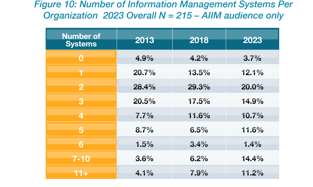.png)
Navigating the Content System Evolution: How Many Content Systems Do You Manage?
Information Governance | Enterprise Content Management (ECM) | Content Services
AIIM Research shows the number of content systems in organizations is on the rise
Organizations everywhere face the challenge of managing an ever-increasing volume of content. From documents and files to multimedia assets and web content, CRMs and ERPs, the pressing need for more broadly encompassing information management has become paramount. According to the AIIM 2023 State of the IIM Industry Report, it is evident that organizations are adopting an increasing number of content systems to handle their diverse content needs.
How Many Content Systems Do You Manage?
 Our research has found that the average number of content systems within organizations has surged from 3.14 to 4.95 over the past ten years. And while the average number of content systems has risen across the board, the most significant growth area has been in organizations with 7-10 systems. In 2013, this category accounted for a mere 3.6% of organizations, but by 2023, it has risen to a notable 14%.
Our research has found that the average number of content systems within organizations has surged from 3.14 to 4.95 over the past ten years. And while the average number of content systems has risen across the board, the most significant growth area has been in organizations with 7-10 systems. In 2013, this category accounted for a mere 3.6% of organizations, but by 2023, it has risen to a notable 14%.
This notable increase in the number of enterprise content stores underscores the challenge of handling various content types efficiently while maintaining streamlined workflows and avoiding information silos.
The Growing Complexity of Content Management
In the last decade, the global business landscape has witnessed a remarkable transformation. The rise of digitalization, the explosion of data, and the growing diversity of content have fueled the demand for more versatile and effective content management systems. Organizations have become more diversified, often working globally and remotely, each producing and managing their own content.
The management challenges are not just with paper, or with content in a digital workflow; teams today work in chat, email, and any number of online collaboration systems. And they’re working with documents, images, video, audio, and a growing host of content and media files. Some of this content is found within modern systems, while much still remains housed in legacy systems that can be decades old.
The growing complexity of content management is an ever-evolving challenge. As a result, rather than strive for a “single source” for enterprise content, many organizations are adopting multiple content systems to get the job(s) done.
Factors Driving the Adoption of Multiple Content Systems
Several factors contribute to the exponential growth of content systems within organizations. This shift overall is toward a diversification in content management approaches, as well as an acknowledgment of the need for specialized systems catering to specific aspects of content management. Consider the following:
- Diverse Content Types – With the evolution of digital media, organizations now manage various content types, such as documents, videos, images, social media posts, and web content. Some systems specialize in handling specific formats, or in support of specific business processes, leading to the adoption of multiple platforms.
- Specialized Departmental Needs – Various departments within organizations require specialized tools to cater to their unique content management requirements. Marketing, sales, HR, finance, and IT departments often utilize distinct systems that align with their specific goals and functions.
- Integration Challenges – Many organizations have existing content systems that have been customized over time. Integrating new functionalities into legacy systems can be cumbersome and lead to the adoption of additional standalone systems.
- Global Operations – Multinational corporations often have offices in multiple countries. Different regions may prefer localized content management solutions, contributing to the proliferation of different systems across the organization. Add to this any regulatory or jurisdictional compliance needs, this can affect the need for additional or multiple repositories.
- Expanding Digital Presence – As organizations expand their online presence through websites, social media channels, and content marketing, they require specialized systems to manage these digital assets effectively.
Challenges of Managing Multiple Systems
While the adoption of multiple content systems can have advantages, it also presents several challenges. Often, each system is added as required as business needs change, and it’s easy to overlook the bigger picture. Here are a few factors to consider:
- Integration Complexity – Integrating diverse systems can be complex and time-consuming, leading to potential disruptions and compatibility issues.
- Training and Knowledge Transfer – Employees may require training on multiple systems, and knowledge transfer between teams can become challenging.
- Data Silos – Each system may operate independently, leading to data silos and hindering cross-departmental collaboration.
- Costs and Maintenance – Managing multiple systems incurs additional costs for licensing, maintenance, and support.
Applying This in Your Organization
Bill Gates’s famous essay written in 1996 was titled “Content is King”, and it’s astonishing how that statement is still 100% valid today. But if you are looking to modernize your approach to content management it is important to effectively structure and manage it. Here are a few best practices to navigate the complex landscape effectively:
- Assess Existing Systems – Evaluate the current content management infrastructure to identify redundancies and potential integration opportunities.
- Prioritize Integration – Wherever feasible, prioritize integrating existing systems to minimize data silos and streamline workflows.
- Adopt Scalable Solutions – Consider content management platforms that offer scalability to accommodate future growth without excessive overhead.
- Centralize Governance – Establish a centralized governance framework to oversee the adoption, integration, and usage of content systems across the organization.
- Employee Training and Support – Provide comprehensive training and ongoing support to employees to ensure they can utilize the systems effectively.
- Security and Compliance Measures – Implement robust security measures to safeguard sensitive data and comply with relevant regulations.
Reflection of Today’s Demands
The growth in the average number of content systems within organizations reflects the evolving demands of modern business operations. Embracing multiple content systems offers the potential for enhanced efficiency, specialized functionality, and scalability. However, organizations must also address the challenges of integration, training, and data silos to optimize the benefits of these systems fully. By adopting best practices and staying agile in their content management approach, organizations can navigate the complexities and successfully and unlock the true potential of their enterprise content.
About Kevin Craine
Kevin Craine is a professional writer, an internationally respected technology analyst, and an award-winning podcast producer. He was named the #1 Enterprise Content Management Influencer to follow on Twitter and has listeners and readers worldwide. Kevin creates strategic content for the web, marketing, social media, and more. He is the written voice for some of North America's leading brands and his interviews feature today's best thought leaders. His client list includes many well-known global leaders like IBM, Microsoft and Intel, along with a long list of individuals and start-ups from a wide variety of industries. Kevin's podcasts have been heard around the world, including the award-winning weekly business show "Everyday MBA". He is also the host and producer of "Bizcast" on C-Suite Radio and the producer behind podcasts for Epson, Canon, IBM and AIIM International, among others. Prior to starting Craine Communications Group, Kevin was Director of Document Services for Regence BlueCross BlueShield where he managed high volume document processing operations in Seattle, Portland and Salt Lake City. He also spent time at IKON as an Enterprise Content Management consultant working with national and major accounts. He was the founding editor of Document Strategy magazine. Kevin has also been, at one point or another, an adjunct university professor, a black belt martial artist, and a professional guitarist. Kevin holds an MBA in the Management of Science and Technology as well as a BA in Communications and Marketing.

